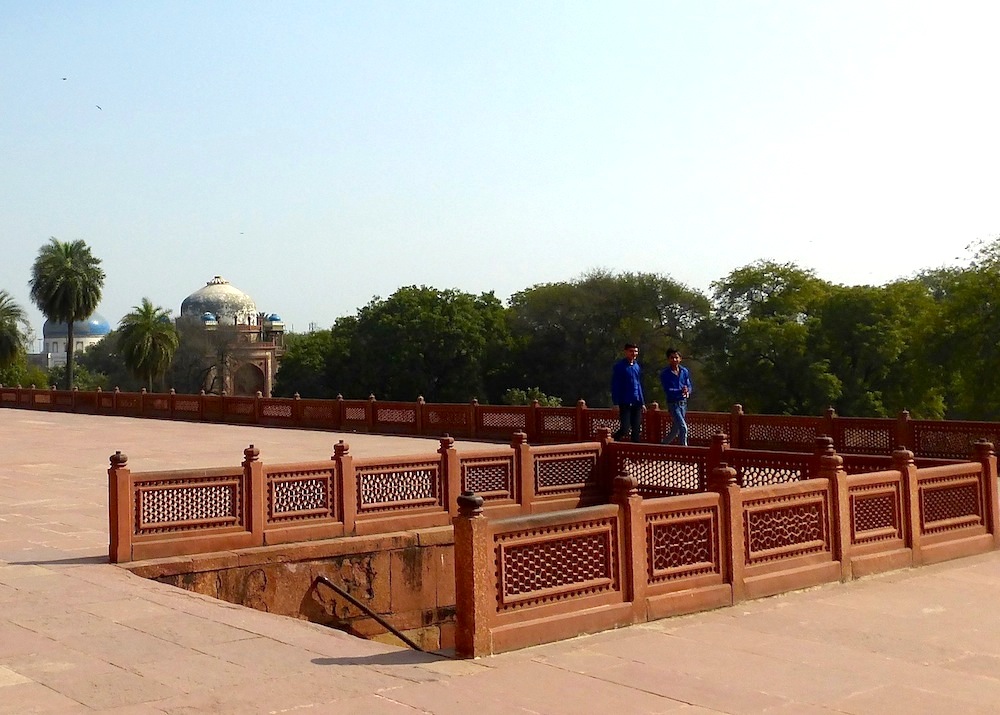Photographs by the author. You may use these images without prior permission for any scholarly or educational purpose as long as you (1) credit the photographer and (2) link your document to this URL in a web document or cite the Victorian Web in a print one. [Click on the images to enlarge them.]

Humayun's Tomb, Delhi. 1565-72. Rubble masonry with red sandstone and white marble (the first to have used these in such quantities), originally with glazed blue tiling for the terrace canopies.
This tomb complex, built for the sixteenth-century Mughal Emperor Humayun, shelters more than a hundred Mughal graves, and is said to have been "the earliest example of Persian influence in Indian architecture" (information taken from the site's information board). Then on the outskirts of town, it is beautifully situated in what is still "one of the most pleasant places in Delhi, and marvellously tranquil" (Peck 151). As might be guessed, its appeal for the Victorian administrators was considerable.


Left: Entrance through the terrace, with a flight of steps leading up through the middle arch. Right: Entrances and windows reached on the upper level, above the terrace and beneath the dome.


Two of the Mughal tombs within the structure's chambers. The one on the right, with the sun shining on it, is Humayun's own tomb, centrally placed and strikingly emphasized by being raised on a three-step platform above marble floor-tiling with a stylised floral pattern and dark borders.
The havoc that British troops wrought on Mughal Delhi in the wake of 1857 was a shameful aberration. It was not at all typical of the way either British architectural historians in India, like James Fergusson (who was horrified by such wanton destruction) or East India Company officials like Sir Thomas Metcalfe, the British Resident in Delhi, responded to monuments like this. Such men, who often developed a profound understanding of Indian culture, appreciated the beauty, refinement and history they found here just as they did at Agra, where the British initiated important restoration work. Metcalfe described this tomb accurately in his Reminiscences of Imperial Dehlie, noting its relation to the Taj Mahal:
It is believed from its Shape to have formed the Model of the more beautiful mausoleum of Agra the Taj Mahal erected by the Emperor Shah Jahan entirely of marble decorated with mosaics over his favorite Queen Moomtaz Muhul.... The Tomb occupies a Site of 165 feet Square and the Terrace on which it stands of 303 feet Square. [in Bayley 15]


Left: Intricately carved geometric and floral designs in the roundels over an inner archway. Right: Balustraded stair-opening for steps to and from the uppermost level.

Looking from the uppermost level towards the entrance gateway to the complex.
The tomb in Delhi had another claim to architectural significance, since it was "the first garden-tomb on the Indian subcontinent" ("View from the Ridge..."). Clearly, this made it a delightful retreat from the bustle of Old Delhi. A pencilled note in Metcalfe's margin reads: "Charlie Feesie Emmie and I spent our Xmas Day 1871 here with the Romaines" (in Bayley 15). It would seem, then, that the Romaines had taken the tomb as their residence, just as Metcalfe himself had taken a humbler tomb in Mehrauli for his own "country" home.
To say that many British admired Mughal architecture and design is not to say that they respected its spiritual significance. When the last Mughal emperor, Bahadur Shah Zafar II, found sanctuary here in 1857, Hodson of Hodson's Horse took command of the entrance, sent in his men, and had no hesitation in winkling the weary octogenarian out of the dynasty's mausoleum. At least his life was guaranteed. On the following day Hodson returned to the tomb to remove the three princes who had been involved in the uprising. No guarantees were given this time, and, in a famous though variously recorded incident, Hodson summarily executed them on the way back into town, killing them with his own Colt revolver (see Dalrymple 397-98).
Related Material
- Engraving of the Tomb from a drawing of 1833
- Sir Thomas Metcalfe's "Dilkusha" or "Heart's Delight," Delhi
- Monument to Major Hodson in Lichfield Cathedral
- Ranjeet Kashyap’s illustrated blog entry on Humayun's Tomb
References
Bayley, Lady Emily. The Golden Calm: An English Lady's Life in Moghul Delhi, ed. M/. M. Kaye. Exeter: Webb & Bower, 1980. (This includes her father's Reminiscences.)
Dalrymple, William. The Last Mughal: The Fall of a Dynasty, Delhi, 1857. Delhi: Penguin, 2007.
Peck, Lucy. Delhi: A Thousand Years of Building. New Delhi: Roli (Lotus), 2005.
"View from the Ridge north of Delhi looking towards the city (left) Humayun's Tomb (right)." British Library Online Gallery. Web. 22 February 2015.
Last modified 22 February 2015
Link added 23 November 2019